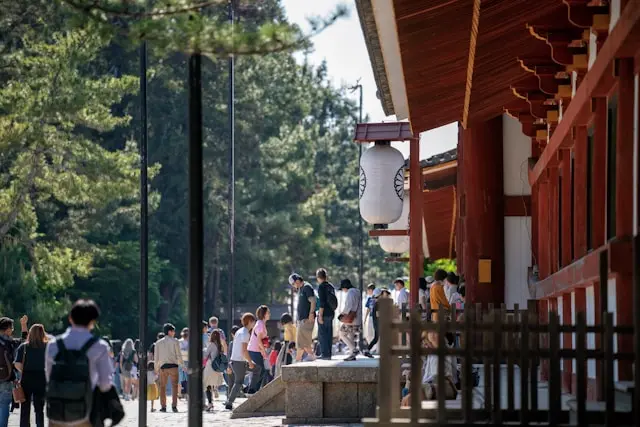
By the 8th century, when the capital was moved to Heijō-kyō (modern Nara City), the Yamato region lost its political prominence. However, because it hasn’t undergone extensive modern development, it has preserved its natural landscapes and cultural heritage. In this ancient city, which predates both Kyoto and Nara in historical significance, you can explore sacred sites and experience the solemn beauty of Japan’s history. It’s also a haven for local delicacies, so let’s dive into what this charming city has to offer.
Getting to Sakurai City
From Nara City, take the JR Sakurai Line from JR Nara Station to Sakurai Station. The journey takes about 30 minutes.
Top Things to Do in Sakurai City
1. Ōmiwa Shrine (大神神社)
Ōmiwa Shrine, nestled at the foot of the sacred Mount Miwa, is considered Japan’s oldest shrine and is steeped in ancient mythology. The shrine grounds are vast, and the entire Mount Miwa itself is venerated as the deity. The faith and devotion associated with this shrine have been passed down for generations.
The shrine’s imposing torii gate, standing 32 meters tall, is a striking landmark visible from afar. Notable spots within the shrine include Sai Shrine, known for its healing powers. Local people frequently visit to pray for health, and the path to the shrine is lined with lanterns donated by pharmaceutical companies. Behind the main hall, you’ll find a sacred spring known as “Mikami Water.” Believed to cure illnesses, many visitors bring bottles to take some home, but there are also disinfected cups available for public use.
• Address: 1422 Miwa, Sakurai City, Nara Prefecture
• Transportation: 3 minutes by JR Sakurai Line from Sakurai Station to Miwa Station
• Visiting Hours: 9:00 AM – 5:00 PM
2. Abe Monju-in Temple (安倍文殊院)
Fans of the game Onmyoji may recognize the name Abe no Seimei, who is said to have been born here. Abe Monju-in Temple, with a history spanning over 1,300 years, is one of Japan’s oldest temples. It was founded in 645 by Abe Kurahashimaro.
Within the temple grounds, you’ll find the stunning “Golden Pavilion Floating Hall” (Nakamarudo), which rests serenely on a reflective pond and enshrines Benzaiten, one of Japan’s Seven Lucky Gods. The temple also houses the Monju-in Nishikofun, an ancient burial mound designated as a Special National Historic Site. Remarkably, its structure, built with perfectly symmetrical stone mounds, has been preserved in its original state for 1,300 years.
• Address: 645 Abe-yama, Sakurai City, Nara Prefecture
• Transportation: 5 minutes by taxi or a 20-minute walk from JR Sakurai Station
• Visiting Hours: 9:00 AM – 5:00 PM
3. Hase-dera Temple (長谷寺)
Hase-dera Temple, the head temple of the Toyoyama sect of Shingon Buddhism, dates back to 686. Revered by nobility during the Heian period, it is affectionately known as the “Temple of Flowers.” Perched in a tranquil mountain setting, the temple boasts stunning seasonal landscapes year-round, from cherry blossoms in spring to hydrangeas and lotus flowers in summer, fiery red maples in autumn, and snowy vistas in winter.
The temple complex includes 30 structures, with the main hall rebuilt in 1650 by the order of the Tokugawa shogunate. The view from the elevated platforms is breathtaking, offering a sweeping panorama of the surrounding mountains.
• Address: 731-1 Hase, Sakurai City, Nara Prefecture
• Transportation: A 15-minute walk from Kintetsu Hasedera Station
• Visiting Hours:
• April–September: 8:30 AM – 5:00 PM
• October–November, March: 9:00 AM – 5:00 PM
• January–February: 9:00 AM – 4:30 PM
• Admission Fee: Adults: 500 yen; Elementary Students: 250 yen
4. Tanzan Shrine (談山神社)
Located in the mountainous Tonomine area of Sakurai, Tanzan Shrine was built in 678. It is named after the historic meeting that took place here during the Taika Reform. Known as the “Nikko of Kansai,” its beautiful vermilion structures stand out against the lush greenery of the mountains. The shrine is also home to the world’s only 13-story wooden pagoda, rebuilt in 1532 after the original was destroyed by fire.
Tanzan Shrine is renowned for its blessings in romantic relationships, and visitors can find a sacred “Love Stone” and a “Shrine of Love” on the grounds. The shrine is especially captivating during autumn when over 3,000 maple trees transform the area into a fiery red landscape. Each year on November 3rd, the shrine hosts the Kemari Festival, a traditional ball game performance by participants dressed in Asuka-period attire.
• Address: 319 Tonomine, Sakurai City, Nara Prefecture
• Transportation: Take a bus from Sakurai Station to Tanzan Shrine; about 25 minutes.
• Visiting Hours: 8:30 AM – 4:30 PM
Surrounded by UNESCO World Heritage Sites, national treasures, and cultural landmarks, Sakurai City offers a glimpse into Japan’s 1,300-year-old history. Its blend of ancient and modern elements creates a charming cityscape that is both timeless and contemporary. Next time you have the chance, consider visiting Sakurai City and embark on a journey through Japan’s rich past!
